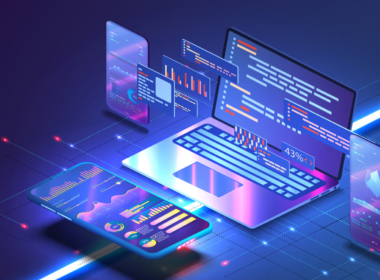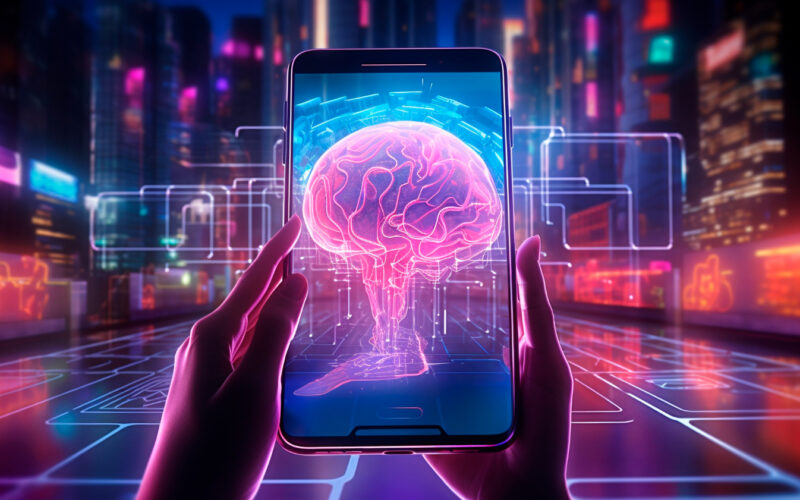Is your business ready to keep up with the latest tech innovations? Data shows that in the next few years, the estimated market value of AI alone will grow by 25 times, from just $189 billion in 2023 to $4.8 trillion in 2033,. This rapid growth indicates a massive shift in how businesses will run and compete.
The fastest-growing companies don’t wait for change. They act early, choose the tools that align with their strategy, and use technology to build a competitive edge in their market.
In this guide, we break down 12 tech innovations that are reshaping how businesses operate, compete, and grow. You’ll get examples and implementation strategies for each, helping you make effective decisions about your technology roadmap. So, let’s get started.
Key Takeaways:
- Tech innovations go beyond basic improvements and create new ways to solve business problems and deliver customer value.
- These 12 technologies deliver measurable benefits like operational efficiency, competitive advantages, better customer experiences, and data-driven decision making.
- AI and machine learning help businesses automate complex tasks and predict outcomes using real-time data from their operations.
- Extended reality technologies like VR and AR reduce training costs and enable remote collaboration that feels natural.
- Smart implementation requires choosing technologies that align with your business needs.
What are Tech Innovations?
Tech innovations are breakthrough technologies that fundamentally change how businesses operate, compete, or deliver value to customers. They represent paradigm shifts that create new possibilities and business models, going beyond incremental improvements to existing tools.
For instance, artificial intelligence enabled machines to learn patterns, make predictions, and automate complex decision-making processes beyond simple calculations. Similarly, blockchain technology established trust and transparency without requiring central authorities rather than creating another database format.
The most impactful tech innovations share three characteristics: they solve real problems, they scale efficiently, and they create competitive advantages for early adopters. Smart business leaders focus on innovations that align with their strategic goals rather than chasing every trending technology.
Tech innovations create real change, but you need to see the specific value they bring to your business. Here’s what these technologies actually deliver when you implement them right.
Benefits of Tech Innovations
Tech innovations deliver measurable value when implemented strategically. These benefits make your business more efficient and competitive.
- Operational Efficiency: Automation reduces manual work while AI optimizes complex processes like supply chain management and resource allocation.
- Competitive Advantage: New technologies help you launch products faster and offer customer experiences that competitors can’t match yet.
- Customer Experience: The real-time support through chatbots and personalized recommendations based on customer data creates better service.
- Data-Driven Decisions: IoT sensors and analytics platforms give you accurate information to make quick strategic adjustments.
- Scalability: Cloud systems and modular software grow with your business without major infrastructure overhauls.
- Risk Mitigation: Advanced cybersecurity and blockchain technology protect your data and create tamper-proof records.
These benefits become reality when you choose the right technologies for your specific situation. Let’s look at 12 innovations that are already changing how businesses operate and compete.
12 Tech Innovations and Trends with Examples
The following innovations are actively reshaping industries and creating new opportunities for businesses that implement them effectively.
- Artificial Intelligence and Machine Learning
Artificial intelligence hit mainstream business adoption around 2018, but 2024 marked a turning point when generative AI models became reliable enough for critical business processes. What started as experimental chatbots has evolved into systems that can analyze contracts, predict equipment failures, and automate complex decision-making.
The current innovation wave focuses on AI that learns continuously from real business data rather than requiring constant retraining. Companies are now deploying AI systems that adapt to changing conditions and improve their performance over time without human intervention.
Example: Netflix uses machine learning algorithms to analyze viewing habits and recommend content to its millions of users. Their recommendation engine drives content engagement and helps the company make data-driven decisions about which shows to produce.
How to apply:
- Customer Service Automation: Set up chatbots that can access your customer database, pull order history, and resolve common issues like refunds or status updates before escalating complex cases to human agents.
- Predictive Analytics: Feed your sales data into ML algorithms to identify which customers are likely to purchase within 30 days, then create targeted email campaigns for those specific segments.
- Process Optimization: Install sensors on production equipment to feed performance data into AI systems that automatically adjust machine settings when quality measurements fall outside acceptable ranges.
- Extended Reality (XR)
Extended reality emerged from gaming and entertainment but gained serious business attention during remote work shifts in 2020-2022. What started as clunky VR headsets for training simulations has evolved into lightweight AR glasses and mixed reality systems that workers can use throughout their regular workday.
The current XR innovation focuses on practical workplace applications rather than flashy demonstrations. Companies are now investing in XR solutions that solve real training costs, reduce travel expenses, and enable remote collaboration that feels almost as natural as in-person meetings.
Example: Boeing uses VR training simulations for aircraft maintenance technicians. Their immersive programs reduce training time while improving retention rates and safety outcomes compared to traditional classroom instruction.
How to apply:
- Employee Training: Create VR modules that simulate dangerous scenarios like chemical spills or equipment failures, allowing employees to practice responses without physical risk or equipment downtime.
- Product Visualization: Build AR mobile apps that let customers point their phones at empty spaces to see how furniture, appliances, or equipment will look before making purchase decisions.
- Remote Collaboration: Use mixed reality headsets to enable engineers in different locations to work together on 3D product designs, manipulating virtual components in real-time.
Multiple industries struggle with training costs and safety risks. Codewave’s XR Application Development helps companies create immersive training programs and customer experiences that reduce costs while improving outcomes. Contact us to explore XR solutions for your business.
- Blockchain Technology
Blockchain started as the foundation for Bitcoin in 2009, but businesses only began serious adoption around 2017 when companies realized its potential beyond cryptocurrency. Early enterprise blockchain projects focused on supply chain tracking, but many failed due to complexity and high costs.
The latest blockchain innovation centers on simpler, more practical applications that don’t require massive infrastructure changes. Companies are now implementing blockchain for specific use cases like document verification, automated contracts, and product authenticity tracking rather than trying to rebuild entire systems.
Example: Walmart uses blockchain to track food products from farm to shelf. When contamination occurs, they can trace the source in seconds rather than days, reducing food waste and protecting consumer safety.
How to apply:
- Supply Chain Transparency: Create blockchain records that show every step in your manufacturing process, from raw material sourcing to final delivery, allowing customers to verify product authenticity.
- Smart Contracts: Program automatic payments to vendors when delivery confirmations and quality inspections are completed, eliminating manual invoice processing and payment delays.
- Digital Identity Management: Issue blockchain-based certificates for employee training completions or customer loyalty program memberships that cannot be forged or duplicated.
- Internet of Things (IoT)
IoT devices started appearing in consumer homes around 2010 with smart thermostats and security cameras, but industrial IoT didn’t take off until wireless networks became reliable and sensor costs dropped dramatically after 2018. Early IoT projects often failed because companies tried to connect everything without clear business cases.
Today’s IoT innovation focuses on targeted solutions that solve specific operational problems rather than general connectivity. Companies are now deploying IoT systems that pay for themselves within months by preventing equipment failures, optimizing energy usage, or automating routine maintenance tasks.
Example: Rolls-Royce uses IoT sensors in its aircraft engines to monitor temperature, pressure, and performance data during flights. Airlines receive predictive maintenance alerts that help prevent engine failures and reduce costly emergency repairs.
How to apply:
- Asset Monitoring: Install temperature and vibration sensors on critical manufacturing equipment that send alerts to maintenance teams when readings exceed normal operating parameters.
- Environmental Control: Deploy smart thermostats and occupancy sensors that automatically adjust heating, cooling, and lighting based on room usage patterns and outdoor weather conditions.
- Fleet Management: Add GPS trackers and diagnostic sensors to delivery vehicles that monitor fuel efficiency, route optimization, and driver behavior for insurance discounts.
- Quantum Computing
Quantum computing research began in the 1980s, but the first practical quantum computers only appeared in research labs around 2016. These systems use quantum physics principles to solve certain types of complex calculations much faster than traditional computers.
IBM, Google, and other tech giants spent years building quantum systems that could barely outperform traditional computers on specialized tasks, leading many businesses to dismiss the technology as purely academic.
The quantum innovation breakthrough came in 2023-2024 when companies started achieving “quantum advantage” for specific business problems like financial modeling and drug discovery.
Current quantum systems are still limited, but the technology is advancing rapidly toward solving complex optimization problems that traditional computers simply cannot handle efficiently.
Example: IBM’s quantum computers are helping researchers at pharmaceutical companies simulate molecular interactions for drug discovery. Complex molecular problems that would take traditional computers years can potentially be solved in days.
How to apply:
- Financial Modeling: Run complex risk assessments across thousands of market scenarios simultaneously to optimize investment portfolios and identify potential losses before they occur.
- Research and Development: Simulate new materials with specific properties like lighter weight or greater durability for product development without building and testing physical prototypes.
- Cryptographic Security: Develop quantum-resistant encryption methods to protect customer payment data and business communications from future quantum-powered cyber attacks.
- Edge Computing
Edge computing gained momentum around 2019 when businesses realized that sending all data to distant cloud servers created delays and bandwidth costs that hurt time-sensitive applications. This approach processes data closer to where it’s created rather than in faraway data centers.
The technology became essential during the pandemic when remote work and video streaming put a massive strain on centralized networks.
Current edge innovation focuses on bringing computing power as close as possible to where data is created and decisions need to happen. Companies are now deploying edge systems that can operate independently when internet connections fail, while still syncing with central systems when connectivity returns.
Example: Tesla’s Autopilot system processes sensor data locally in each vehicle rather than sending it to remote servers. This edge computing approach enables split-second decisions required for autonomous driving safety.
How to apply:
- Real-Time Analytics: Install edge computing devices on manufacturing floors that analyze sensor data immediately to detect quality issues and stop production lines before defective products are created.
- Content Delivery: Cache your most popular website content and application data at edge locations closer to users to reduce page load times and improve customer experience.
- Offline Capabilities: Deploy edge servers at retail locations that can process point-of-sale transactions and inventory updates even when internet connectivity is temporarily unavailable.
- 5G and Advanced Connectivity
5G networks started rolling out commercially in 2019, but early deployments disappointed businesses because coverage was limited and most applications didn’t need the extra speed. The real 5G innovation began in 2023 when networks became reliable enough to support critical business operations and new applications that weren’t possible with older wireless technology.
Current 5G innovation focuses on enabling applications that require instant response times and massive device connectivity. Companies are now building autonomous systems, remote operations, and IoT networks that simply couldn’t function properly on previous wireless networks.
Example: Ericsson’s 5G network enables remote operation of mining equipment in Sweden from control centers hundreds of miles away. Operators can control excavators and trucks with minimal delay, improving safety while maintaining productivity.
How to apply:
- Mobile Workforce: Give field technicians 5G-enabled tablets that can stream high-resolution equipment manuals, video consultations with experts, and cloud-based diagnostic tools in real-time.
- IoT Deployment: Connect thousands of sensors across large facilities like warehouses or manufacturing plants without network congestion affecting performance or response times.
- Autonomous Systems: Deploy delivery drones and warehouse robots that require instant communication with central control systems for navigation, safety, and task coordination.
- Robotic Process Automation (RPA)
RPA emerged around 2015 when businesses started looking for ways to automate repetitive computer tasks without replacing their existing software systems. Early RPA projects often broke when software interfaces changed, leading to mixed results and skeptical IT departments.
Current RPA innovation focuses on building more reliable automation that can handle variations and exceptions in business processes. Companies are now deploying intelligent RPA systems that combine basic automation with AI capabilities, creating digital workers that can adapt to changing conditions and learn from experience.
Example: American Express uses RPA to process credit card applications. Their automated system handles routine verification tasks, reducing processing time from days to minutes while improving accuracy and customer satisfaction.
How to apply:
- Data Entry and Migration: Program RPA bots to extract customer information from email inquiries and automatically populate CRM systems while flagging incomplete or inconsistent data for human review.
- Customer Onboarding: Create automated workflows that pull data from new customer applications, verify information against databases, and set up accounts while sending welcome emails and next steps.
- Report Generation: Build RPA processes that collect sales data from multiple departments every month, compile it into standardized reports, and distribute them to executives automatically.
Many companies waste hours on repetitive data tasks that could be automated. Codewave’s Process Automation services help you identify which processes to automate first and implement solutions that free your team for higher-value work. Get started with our automation assessment.
- Cybersecurity Mesh Architecture
Traditional network security worked well when employees worked from offices and companies controlled their own servers, but remote work and cloud adoption broke the old perimeter-based security model. Cybersecurity mesh is a security approach that protects individual users and devices rather than just network boundaries. This innovation emerged around 2021 as companies realized they needed to adapt their security strategies for distributed workforces.
Current cybersecurity innovation focuses on treating every access request as potentially dangerous, regardless of where it comes from. Companies are now implementing security systems that verify user identity and device health continuously, creating a flexible security layer that follows employees and data wherever they go.
Example: Microsoft’s Zero Trust security model treats every access request as potentially compromised, regardless of location or device. Companies implementing Zero Trust architectures report significant reductions in security incidents and faster threat response times.
How to apply:
- Remote Work Security: Implement identity verification and device health checks that must pass before employees can access company applications, regardless of their location or network.
- Cloud Migration: Deploy security controls that move with your applications and databases as they transition between on-premises servers and cloud environments.
- Third-Party Access: Create secure access tunnels that allow vendors and partners to reach specific systems they need without exposing your entire network to potential risks.
- Sustainable Technology Solutions
Sustainable technology became a business priority around 2019 when companies realized that environmental regulations were tightening and customers were making purchasing decisions based on sustainability practices. What started as simple recycling programs has evolved into comprehensive approaches that reduce costs while meeting environmental goals.
Current sustainable innovation focuses on technologies that deliver immediate cost savings alongside environmental benefits. Companies are now implementing smart energy systems, circular economy processes, and sustainable supply chain technologies that improve their bottom line while reducing their environmental impact.
Example: Interface uses renewable energy and carbon-negative manufacturing processes to produce carpet tiles. Their Mission Zero initiative eliminated their environmental footprint while reducing production costs over five years.
How to apply:
- Energy Efficiency: Install smart building management systems that learn usage patterns and automatically optimize heating, cooling, and lighting schedules to reduce utility bills.
- Circular Economy: Design products with modular components that customers can easily repair, upgrade, or return for recycling, creating ongoing revenue streams.
- Supply Chain Optimization: Use route optimization software and electric delivery vehicles to reduce transportation emissions while maintaining or improving delivery times.
- Low-Code and No-Code Platforms
Low-code development emerged around 2016 when companies realized that traditional software development was too slow and expensive for many business needs. Early platforms were limited and created applications that didn’t scale well, but the technology matured significantly when major cloud providers started offering enterprise-grade low-code solutions around 2020.
Current low-code innovation focuses on enabling business users to create sophisticated applications without overwhelming them with technical complexity. Companies are now using low-code platforms to rapidly prototype ideas, automate workflows, and build customer-facing applications that integrate seamlessly with existing enterprise systems.
Example: Domino’s Pizza uses a low-code platform to rapidly develop and deploy customer-facing applications across different markets. Their teams can create new ordering experiences and promotional campaigns in days rather than months.
How to apply:
- Rapid Prototyping: Build and test new customer service workflows or inventory tracking applications in weeks to validate ideas before investing in full development projects.
- Workflow Automation: Enable department managers to create custom approval processes, data collection forms, and reporting dashboards without waiting for IT resources.
- Legacy System Integration: Connect older databases with modern applications using visual development tools and pre-built connectors that require minimal technical expertise.
Legacy systems holding back your innovation efforts? Codewave’s Custom Software Development combines low-code rapid prototyping with full-scale engineering to modernize your technology stack efficiently. Schedule a consultation to explore your options.
- Natural Language Processing (NLP)
Natural language processing existed in research labs for decades, but business applications only became practical around 2018 when deep learning models became powerful enough to handle real-world language complexity.
NLP is a technology that enables computers to understand and generate human language in natural conversations and written text. Early NLP systems could barely understand simple commands, but recent advances in large language models have created systems that can analyze documents, generate reports, and hold conversations that feel natural.
Current NLP innovation focuses on understanding context and nuance rather than just processing keywords. Companies are now deploying NLP systems that can analyze customer feedback for emotional tone, extract specific information from complex documents, and enable workers to interact with business software using natural conversation instead of learning complicated interfaces.
Example: JPMorgan Chase uses NLP to analyze documents and contracts. Their COIN system processes in seconds what previously took lawyers thousands of hours annually, while improving accuracy and consistency.
How to apply:
- Document Processing: Deploy NLP tools that extract key information like dates, amounts, and parties from contracts and invoices, then automatically populate your accounting and CRM systems.
- Customer Sentiment Analysis: Monitor social media mentions, customer reviews, and support tickets to identify recurring issues and measure brand perception trends over time.
- Voice Interfaces: Enable employees to retrieve sales data, generate reports, and update customer records using natural language voice commands instead of complex software interfaces.
These 12 innovations offer clear paths to growth, but choosing and implementing the right ones requires technical expertise and strategic thinking. You need a partner who can help you make smart technology decisions.
Get Ahead with Smart Technology Choices Through Codewave
These tech innovations create tremendous opportunities, but implementing them successfully requires expertise in both technology and business strategy. Many companies struggle to translate cutting-edge concepts into practical solutions that deliver measurable results.
Codewave specializes in design-thinking-led digital innovation that connects technology capabilities with business outcomes. We help businesses identify which technologies align with their goals and create custom solutions that drive real value.
How we help:
- AI/ML Development: Build intelligent systems that automate your specific processes and generate actionable insights for your industry.
- XR Application Development: Create immersive customer experiences and employee training programs that engage users effectively.
- Custom Software Development: Design applications that integrate emerging technologies with your existing systems seamlessly.
- IoT Development: Connect your physical assets to digital systems for real-time monitoring and automated control.
- Digital Strategy Consulting: Develop comprehensive technology roadmaps that prioritize innovations based on ROI and business impact.
Codewave has successfully executed over 250 digitization projects across 15 countries, helping SMEs and enterprises leverage technologies like AI, analytics, and cloud solutions to drive growth and competitive advantage. Explore our portfolio to learn more about the work we have done.
Ready to turn innovation into competitive advantage? Codewave helps forward-thinking companies implement the right technologies at the right time, with custom solutions designed for your unique challenges and opportunities. Contact us today to explore how these innovations can advance your business.
FAQs
- What is the difference between tech innovation and technological advancement?
Tech innovation creates new ways of solving problems or doing business, while technological advancement improves existing solutions. Innovation changes what’s possible; advancement makes current solutions better.
- Which tech innovations have the fastest return on investment?
Process automation, AI-powered customer service, and IoT monitoring typically show returns within months. The key is choosing technologies that solve expensive existing problems.
- How do I know which tech innovations are right for my industry?
Look for technologies that address your industry’s specific pain points and regulatory requirements. Study how successful competitors are using technology and identify gaps you can fill.
- What are the biggest challenges when implementing new technologies?
Poor planning, inadequate training, and choosing solutions that don’t integrate with existing systems. Always start with pilot programs and ensure you have proper change management support.
- How long does it typically take to see results from tech innovation projects?
Simple automation projects show results in weeks, while complex AI or IoT implementations can take months. Success depends on project scope, team readiness, and change management effectiveness.
Codewave is a UX first design thinking & digital transformation services company, designing & engineering innovative mobile apps, cloud, & edge solutions.







